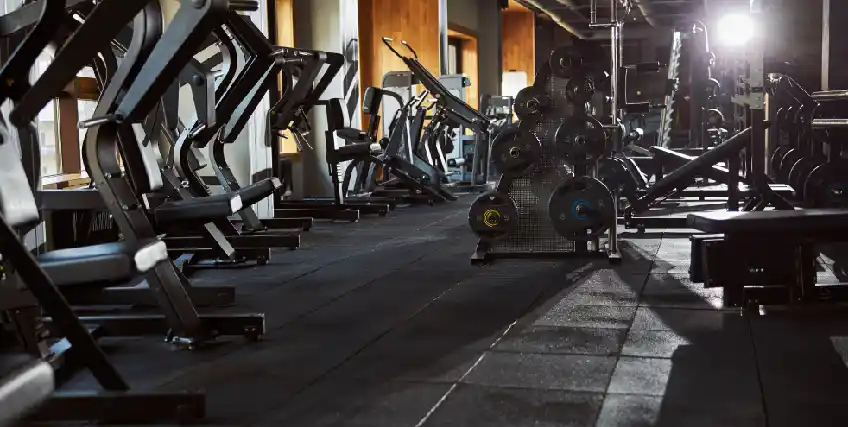How Much Does It Cost to Open a Yoga Studio?
March 18, 2025 | Last Updated on: March 19, 2025

Over the past decade, health and wellness trends in the United States have soared. As part of this , yoga – which has long had a loyal and dedicated following – has seen an increase in popularity as well. With deep roots going back to 5,000-year-old Indian traditions, yoga has simply changed from an exotic form of exercise into a mainstream wellness activity in the U.S., attracting millions of practitioners.
According to Statista, more than 34 million people in the U.S. practiced yoga in 2023 — a small bump from 2022. That's nearly nine million more people practicing yoga compared to 2014. This growing interest means that aspiring entrepreneurs see potential in opening your own yoga studio, offering a blend of physical fitness and mental well-being to their communities.
One reason why it might be a good idea to open a yoga studio is the relatively low startup costs, especially for instructors who also are the owners. Also, if we compare opening a yoga studio to fitness centres that require extensive equipment, yoga studio equipment need is minimal at best. You can host a class with just a simple mat and open space, making opening a yoga studio more affordable than many other ventures. For many Americans, this type of low initial costs makes owning a yoga studio a more accessible way to start their entrepreneurial journey, even those with limited initial capital.
With this article, we will explain various expenses involved in opening your own yoga studio and provide a clear roadmap to help small business owners navigate the process.
Assessing Your Market
When planning to open a yoga studio, you must remember that market analysis is very important before you fully commit to the venture. As an entrepreneur, it is important for the success of your business that you understand the local population’s demographics, income levels, and interest in wellness and fitness. If analysis shows that several studios already exist in your area, then the feasibility of starting yoga business may be affected. Market analysis also helps entrepreneurs to identify gaps such as underserved age groups or specialty yoga offerings, which can help you differentiate your fitness studio from your competitors.
Build a Business Plan
A thorough business plan is critical if you plan to open a yoga studio. It should outline your market research, competitive analysis, operational strategy, revenue model and financial plan. While creating a business plan, remember to add the following key sections:
- Executive Summary: It is a brief overview of your vision and core offerings.
- Products and Services: You can share detail of your class packages, such as memberships offering vinyasa or ashtanga yoga, hot yoga, or restorative yoga.
- Revenue Model: Some yoga studios charge per class, offer packages, or even memberships. You should define how your business plan will generate revenue for your business.
- Marketing and Promotion: Your marketing plan should highlight your strategies for brand promotion using social media campaigns, referral incentives, and community events.
- Competitor Analysis: Assess local competitors to figure out your differentiating factor - it can be pricing, class variety, or even ambiance.
- Operations Plan: This section covers day-to-day management, hiring processes, and financial strategies.
A well-structured business plan not only helps you solidify your ideas but is also essential if you apply for financing to open a yoga studio.
Why Is the Business Plan Important?
You might now be wondering what exactly you need the business plan for. Well, outside of it being a great opportunity for you to clarify your ideas and get them onto paper, it will enable you to assess whether you have a viable business plan to open a yoga studio and opportunity on your hands. At the same time, when you go to a lender to ask for financing, they will want a clear and detailed business plan to make sure they are not taking a risk in lending you the money. The more thorough, detailed, and realistic your plan is, the less hesitancy banks will have about loaning you money. This not only will help you get approved for a loan, but it also might help you get a better interest rate.
How Much Does It Cost to Open a Yoga Studio?
What does it cost to open a yoga studio? While the actual cost to open a yoga studio varies based on the size of the studio, the location, and the surrounding market (i.e. property values in the area), starting yoga business typically cost around $15,000 to $100,000 to start. This makes the yoga industry one of the easiest industries to break into.
In this next section, we’ll break down the different aspects of opening a yoga studio that drive these costs. For your reference, a basic yoga studio with enough room to hosts classes with 25 yoga students comfortably with some room to spare would be around 1,000 square feet.
Costs of Running a Yoga Studio
Mortgage Down Payment or Rent
The biggest cost you will incur in opening a yoga studio is the mortgage down payment or rent security payment. This will vary considerably based on where you are looking to open a studio (i.e. property in New York City is more expensive than property in the suburbs of Atlanta) and what the cost per square foot is in the area.
Across the United States, retail spaces have an average cost of around $200/square foot. As such, you can expect a 1,000 square foot yoga studio retail space to be about $200,000.
If you decide to rent since it is a commercial lease you can expect to have to agree to a lease of at least two years (sometimes longer) with an upfront security deposit of 6 to 12 months' rent. For example, if you are paying $20/square foot for a 1,000 square foot retail space, you can expect to have to pay $10,000 to $20,000 as a security deposit upfront.
Remodelling, Refurbishments, and Décor
Odds are the retail space you are buying or renting is not perfectly set up to host a yoga studio. To turn it into a proper yoga studio space, you will probably have to invest in some remodelling and renovations, such as painting the walls, replacing the floor, and adding in some decorations. For example, many yoga studios have floor to wall mirrors and wood floors. You may also need to add a sound system to complement your yoga sessions. Decorations are also common in yoga studios since many studios try to capture a certain theme or feeling as part of their yoga classes.
Since remodelling, refurbishment, and decor decisions are highly variable and depend upon the business owner, the costs associated with them can fluctuate drastically.
As a quick tip, make sure to factor in remodelling and refurbishment costs when selecting a location.
Yoga Equipment
As already noted, one of the things that make opening a yoga studio so inexpensive compared to many other business models is the lack of need of expensive yoga studio equipment.
The equipment you will need will mostly depend on your studio’s policies. For example, you might require that students bring their own mats, or maybe you provide a free mat for your potential customers. However, you might choose to reuse mats and clean them between sessions. If this is the case, you will need to pay upfront for non-slip yoga mats.
In addition to mats, you will probably want to purchase reusable towels for yoga students to use during classes. Yoga blocks, yoga bolsters, and yoga straps are also common yoga equipment that studios use.
Business License and Permits
To open a yoga studio, you will also require you to obtain a business license and other permits depending upon the laws and regulations of your locality. Depending on your state and county governments and their laws, you might also incur legal fees in the process of obtaining these licenses. You can expect to spend anywhere from $500 to $2,000 on obtaining these different licenses and permits.
POS System and Technology
To operate your business, you will also need a point-of-sale system and technology to operate it on. This means you will have to purchase either a desktop computer or one or two tablets (such as an iPad) to run a point of sale (POS) system. POS systems allow you to collect payments, process credit cards, keep track of memberships, and more.
When choosing a POS system be sure to research your options carefully. Some POS systems have extra functionality, such as the ability to run a loyalty program or offer gift cards. Remember, it is better to choose a system that has more functionalities and capabilities than you think you will need than to choose one that you think may be missing some features you will need in the future. This will ensure that you won’t have to make a time-consuming and labour-intensive migration to a new POS system in the future.
Initial Marketing Budget
An effective marketing campaign is crucial to attract members when you open a yoga studio. From digital ads to community outreach, allocating substantial amount for initial marketing efforts and marketing strategy is recommended. Promoting unique classes, special events, or even discounts on equipment can help boost awareness.
Insurance
In order to start operating your business, you will need to budget for insurance to cover your liabilities. As with any business, opening a yoga studio comes with liabilities. Someone could get hurt in one of your classes and bring a lawsuit against you – liability insurance will protect you against this. You will also need workers’ compensation insurance. There are other insurances you may need in addition to these, so we recommend seeking out a qualified broker who can help you analyze and assess the needs of your business. Remember, while you don’t want to pay more for insurance than you have to, it is always better to have too much coverage than too little. Lawsuits can be costly and mean the end of an otherwise healthy and successful business.
Hiring Employees
Hiring yoga instructors, yoga teachers and administrative staff is another important expense in opening a yoga studio. To attract and retain skilled instructors, competitive wages, flexible schedules, and professional development opportunities should be part of your plan.
Conclusion
There is no doubt that starting a new business is not easy work. It takes time and effort. However, with the proper approach owning and operating your own business can be incredibly rewarding.
As noted, one of the great things about opening a yoga studio is that there really isn’t that much upfront risk in comparison to other industries. Getting your yoga studio business started is a lot cheaper than opening a restaurant, gym, or hotel. This makes it a great option for individuals who do not have access to a great deal of capital. So, if you are willing to put in the time to build out a detailed and thorough business plan, odds are you can be on your way to running a successful and profitable business in no time.
FAQs on Opening a Yoga Studio
1. What is the biggest challenge when you open a yoga studio?
One of the biggest challenges when you open a yoga studio is building a strong client base in a competitive market. Differentiating your studio with unique offerings, like themed classes, workshops, or community events, can help. Securing qualified instructors and managing ongoing operational expenses are also critical. Careful planning and understanding your target audience can improve your chances of success.
2. What are the profitable services when you open a yoga studio?
When you open a yoga studio, offering a range of services can boost profitability. Monthly memberships, class packages, private lessons, workshops, and teacher training programs can diversify revenue. Selling branded merchandise, yoga mats, and wellness products can add extra income. Successful studios often pair regular classes with seasonal events or retreats, creating new opportunities for revenue beyond standard class fees.
3. How can I market my new yoga studio?
To successfully open a yoga studio and attract clients, a multi-channel marketing approach works best. Build a strong social media presence on Instagram, Facebook, and TikTok to showcase your classes and community vibe. Collaborate with local wellness brands and influencers and offer introductory discounts. Listing your studio on Google Maps and yoga-specific directories helps potential students find you. Hosting free community classes also creates word-of-mouth buzz.
4. What types of yoga are popular when you open a yoga studio?
When you open a yoga studio, offering a variety of class types appeals to a broader audience. Popular options include Vinyasa, Hatha, Hot Yoga, Yin, and Power Yoga. Specialty classes like prenatal yoga or meditation-infused sessions can attract niche markets. Knowing your target audience and adjusting your schedule based on demand is essential to keeping your offerings fresh and your studio competitive.
5. What are the ideal financing options to open a yoga studio?
When you open a yoga studio, financing options include small business loans, equipment financing, personal savings, or investor funding. SBA loans can offer favorable terms, but alternative lenders can provide faster approvals. Crowdfunding can also work if you have community support. Whether you need funds for yoga studio equipment or marketing expenses, matching the right financing option to your studio’s needs can help ensure a smooth launch.




